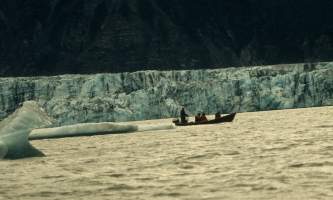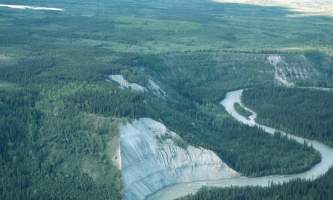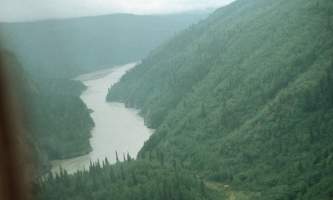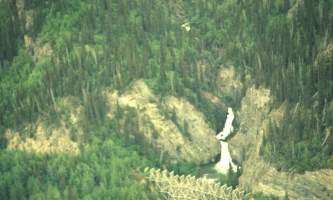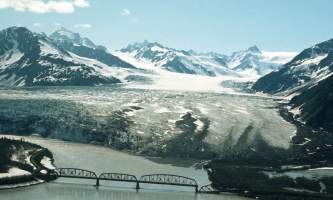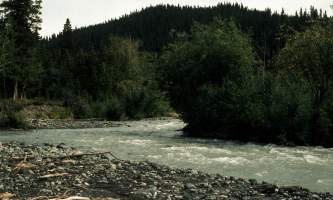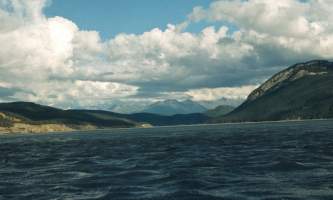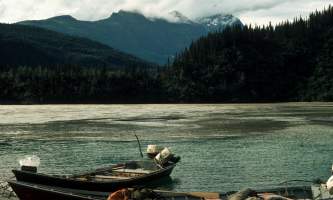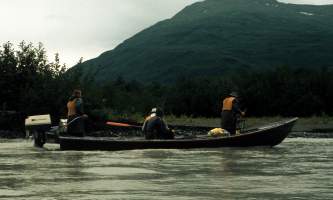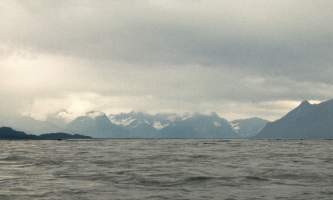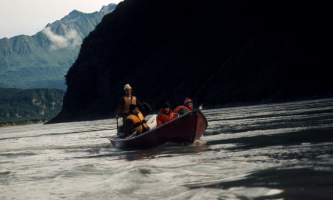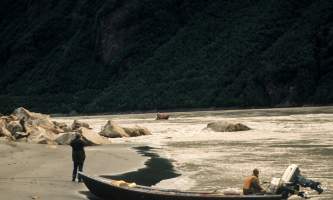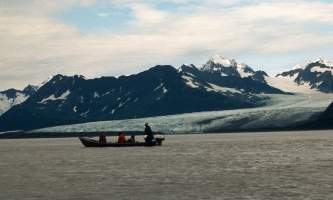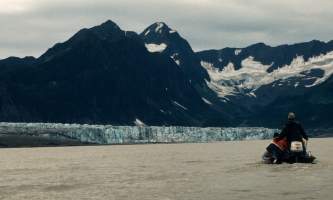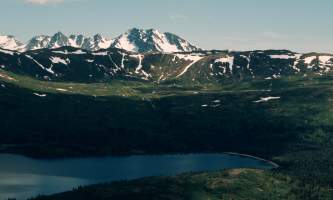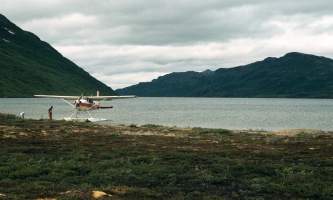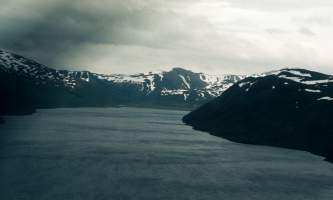Why Float This River
The Copper River and its many tributaries drain one of the greatest regions of mountain, ice, snow and forest in North America. It is a giant river in its lower reaches, often flowing at rates over 200,000 cubic feet per second, while its headwater tributaries flow down steep, rocky gorges and through wide, braided glacial valleys. It is in a region that encompasses subarctic to temperate zones within a latitude range of 60 to 62 degrees. It drains the western side of one of the world's largest nonpolar ice fields where Mt Logan at over 19,000 feet reigns, and where the largest collection of peaks over 14,500 feet in North America exist. All this is located within the largest contiguous protected parklands in the world! The most common trip is the 80 miles from Chitina to Cordova and takes 5 to 7 days. Rafts up to 18 feet are good and canoes are a bit tippy.
Put In
The longest trip possible on the Copper is the 247-mile stretch that starts at its headwaters at Copper Lake and a floatplane is needed to take you and your gear there.
That being said, one of the financial beauties of this river, for all other options, is the road access for put ins and take outs, eliminating the costly means of flying in or out from the river.
The first possible put in is from the Nabesna Road off the Glenn Highway and where it crosses the Slana River. A short distance of 5 to 6 miles down the Slana takes you to the upper Copper River. There are other possible starting points along the Glenn Highway, Highway 1, where it crosses some of the larger tributaries such as the Chistochina, Gulkana and Gakona Rivers. In each case only a short distance of 5 to 8 miles separates you from the braided upper Copper River. There are similar starting scenarios along the Richardson Highway, Highway 4, where it crosses the Tazlina, Klutina,and Tonsina Rivers. Also, along the Edgerton Highway, Highway 10, there is limited access at Lower Tonsina and at Chitina townsite. One of the easiest and most common put ins is along the eastern shore of the Copper, just upstream of the McCarthy Road Bridge and above the confluence with the Chitina River. It is a very scenic location with native fish wheels and the Wrangell Mountains as a backdrop. Here starts an 80-mile section of classic glacial river country that pours south through Wood Canyon and through Abercrombie rapids and past huge glaciers.
Take Out
As far as take outs, for travelers of the upper Copper River country, the common take out would be either, Chitina, or the eastern shore of the Copper River upstream of the McCarthy Road Bridge.
However, the lower Copper River is the true wilderness classic and is only accessible to those who go beyond the McCarthy Road Bridge to above the Copper River delta region. Many groups will take out along the western shore, just upstream of the Million Dollar Bridge, which is the old railroad bridge to the copper mines of yesteryear. It has been converted to accommodate highway vehicles and connects to the town of Cordova. Other groups will bravely float past the towering face of the Child's Glacier, just below the Million Dollar Bridge, and take out at the Flag Point Bridge but missing this takeout by taking a wrong channel has dire consequences. Either way, the take out involves some serious logistical planning, as the town of Cordova is only accessible by Alaska State Ferry or commercial airline. You will need to coordinate a driver and vehicle to arrive in Cordova by ferry, the day before your take out date. Then everyone and all gear will board the return ferry to Valdez for the drive home or to Anchorage. You could send just gear and vehicle by ferry with people flying Alaska Airlines from Cordova to Anchorage.
The Trip
Upper Copper from Headwaters to Chitina: 140 or 165 miles
If you choose to fly in to Copper Lake, an additional 25 miles is added to the total for this stretch. If you start at the first road access at the Slana River Bridge, the trip is roughly 140 miles to Chitina. The bridge is only 1.5 miles from the Glenn Highway near GPS N 62 degrees and 42.3 minutes by W 143 degrees and 56.6 minutes. Once you are on the Copper you will find a slow moving and lightly braided stream with Mount Sanford dominating the southern sky. The river continues at a leisurely pace but stay ready for sweepers and logjams through here. Once near the confluence with the Chistochina, the current picks up and choosing channels becomes the drill. All along the river, the skyline is filled with Mt Sanford and Mount Drum and eventually Mount Wrangell, the highest active volcano in Alaska. There are several sections of strong hydraulics between the Gakona and Tazlina Rivers. Once past the confluence of the Gulkana River, the Copper River starts to gain much volume and has a swift current with sandbars and logjams to be wary of as well as strong eddy lines where converging currents are found. Here the river begins a due south course as it flows past Glennallen and Copper Center. Where the river begins a swing to the SSE, it makes its journey around the massive Mt Wrangell. The tributaries are endless now and the water flow is quite large with more big braided sections and many possible channels to take. You know you are on the final approach to McCarthy Road when the river swings back to a due south direction and the big riverside fish wheels start to line the river. The beach on the right side of the river at GPS N61 degrees and 31 minutes by W 144 degrees and 25 minutes marks the end of this section.
Chitina to Million Dollar Bridge: 80 miles
This is the classic Copper River section that most commercial rafting companies offer tours and is a great wilderness journey. Here the river is already a big strong river with fierce eddy lines and strong standing waves. It is also a very popular fishing destination and many motorboats hauling people and their dip nets up and down through Wood Canyon are seen. The river through Wood Canyon is a strong, single channel starting around GPS N 61 degrees and 26 minutes and on down past Canyon Creek. Just below the McCarthy Road Bridge, entering on the left side of the river is the huge Chitina River. Now the river is truly big. Just crossing from one side of the river to the other takes advanced planning as the 12-mile an hour current sweeps you along. O'Brien Creek enters on the right side of the river and is the last road access point along this stretch. After this is Wood Canyon where there are no rapids but strong hydraulics are present, especially along the shoreline areas. Throughout this stretch of river you can see remnants of the old railroad that hauled copper ore down to Cordova. Spirit Mountain looms downstream on the left of the river for many miles. Tiekel River and Dewey Creek join the river at GPS N 61 degrees and 13.2 minutes by W 144 degrees and 51.8 minutes. Great camps are here.
Now the river is wide and strong and after a few more miles the Chugach National Forest boundary becomes the river shore, while on the left is still the Wrangell-St Elias National Park. Soon on the river’s left is a feature known as The Peninsula. This marks your approach to the confluence with the Bremner River. One of the classic hikes is from the Copper across a huge expanse of sand to view the Bremner River at a point before it joins the Copper. You can pull over to the left at one of the early walls of sand that form the left shore near GPS N 60 degrees and 58 minutes by W 144 degrees and 45 minutes. This area is alive with grizzly bears so keep your group noisy and together. Even harbor seals come this far upriver as they follow the massive Sockeye salmon run. Things are off the scale huge here, especially where the Bremner and the Wernicke and the Copper River meet. All the sand you have seen is the result of the river having been damned up numerous times by the huge Allen Glacier just below this confluence area. Once past the Allen Glacier you are on the fast track to the end of the trip and be wary of the next feature, Abercrombie rapids, which follows just after Baird Canyon.
It is well advised to pull over to the left above Abercrombie to walk down and scout this big water stretch. Rafts have flipped here but there is a fairly clean left-of-center line through here. Be careful, the big exploding haystack waves come from nowhere sometimes. If you do scout, take your bear spray as this is a primary fishing spot for grizzlies. After Abercrombie the river spills out into Miles Lake with the giant Miles Glacier to your left and the Million Dollar Bridge visible in the distance. Be sure and pull far right as you approach the bridge to make sure you get stopped where your vehicles are. The drive to Cordova is about 70 miles from this point with a nice park facility just off the road where you can see the face of the Childs Glacier as it calves directly into the raging river.
Million Dollar Bridge to Flat Point Bridge: 25 miles
Once you leave Miles Lake you are sharing the river with giant icebergs and once below the bridge you are committed to the extra 25 miles to Flag Point. You should not plan on taking out at the steep rocky bank at the visitor’s park opposite the Child’s Glacier, as the danger of tsunami waves is great.
It is necessary to stay way right after you are safely past the face of Child's Glacier to be sure you are right of Long Island or you will be heading for the ocean. Staying right of Long Island and Round Island will put you where you need to be. There is decent access on the upriver side of the bridge on far river right. From here the drive to Cordova is about 40 miles.
Other Advice
- Be well advised to not stop on the left side of the river opposite of Child's Glacier. I have seen with my own eyes calving of such size that large tsunami like waves are pushed up the 20-mile an hour current along the shore creating a boiling wall of water at shoreline. The force of the river would eat any raft parked here. If you are floating past, the wave will flow under your raft but along the shore, it is carnage! It is best advised to stop there in your vehicle as you leave the river trip to view this amazing glacier face.
- This entire trip is along one of the greatest salmon runs in the state and as a result the grizzly bear population is high, so take all precautions of food storage, clean camps, no food in tents and hike as a group making plenty of noise as you go.
- This area is also known for extremely heavy rainfall. Good rain gear and tents are mandatory and the mosquito population is high during midsummer.
- Also note, the foliage of this climate is very thick and one plant in particular, Devil's Club will stop most people in their tracks. Leather gloves can make it easier to pass some of this spiny obstacle.
Copper River GPS Coordinates
Edgerton Highway at Lower Tonsina
Only a short distance of 5 to 8 miles separates you from the braided upper Copper River. Put in option for Copper River.
61.65158600, -144.65463600
Edgerton Highway at Chitina Townsite
Put in/Take out Option for Copper River.
61.52523200, -144.41393900
Nabesna Road at Slana River
A short distance of 5 to 6 miles down the Slana takes you to the upper Copper River. Put in option for Copper River.
62.70478100, -143.94623300
Copper Lake
The longest trip possible on the Copper River is the 247-mile stretch that starts at its headwaters at Copper Lake and a floatplane is needed to take you and your gear there. Put in option for Copper River.
62.70083300, -143.93500000
Richardson Highway at Tonsina River
Only a short distance of 5 to 8 miles separates you from the braided upper Copper River. Put in option for Copper River.
61.66279200, -145.18193700
Glenn Highway at Chistochina River
Only a short distance of 5 to 8 miles separates you from the braided upper Copper River. Put in option for Copper River.
62.60155700, -144.63798500
Flag Point Bridge
Missing this take out by taking a wrong channel has dire consequences. Either way, the take out involves some serious logistical planning, as the town of Cordova is only accessible by Alaska State Ferry or commercial airline. You will need to coordinate a driver and vehicle to arrive in Cordova by ferry, the day before your takeout date. Then everyone and all gear will board the return ferry to Valdez for the drive home or to Anchorage. You could send just gear and vehicle by ferry with people flying Alaska Airlines from Cordova to Anchorage. Take out option for Copper River.
60.43583300, -145.08361100
Glenn Highway at Gulkana River
Only a short distance of 5 to 8 miles separates you from the braided upper Copper River. Put in option for Copper River.
62.26936000, -145.38385400
Upstream of McCarthy Road Bridge
One of the easiest and most common put ins is along the eastern shore of the Copper, just upstream of the McCarthy Road Bridge and above the confluence with the Chitina River. It is a very scenic location with native fish wheels and the Wrangell Mountains as a backdrop. Here starts an 80-mile section of classic glacial river country that pours south through Wood Canyon and through Abercrombie rapids and past huge glaciers. Put in/Take out option for Copper River.
61.53662700, -144.37666700
Upstream of Million Dollar Bridge
Many groups will take out along the western shore, just upstream of the Million Dollar Bridge, which is the old railroad bridge to the copper mines of yesteryear. It has been converted to accommodate highway vehicles and connects to the town of Cordova. Take out option for Copper River.
60.67343100, -144.74603900
Richardson Highway at Tazlina River
Only a short distance of 5 to 8 miles separates you from the braided upper Copper River. Put in option for Copper River.
62.05436800, -145.42759900
USGS Maps
Iliamna C-3, C-4, C-5
Nabesna B-6, C-6
Gulkana A-3, B-2, B-3, C-1, C-2
Valdez A-3, B-2, B-3, C-2, C-3, D-3, D-4
Cordova B-3, C-2, C-3, D-2, D-3
Distance
80-247 miles
Days
5-14
Difficulty
Easy/Moderate
Class
II
Craft
Canoe
Kayak
Raft
Cost
$


